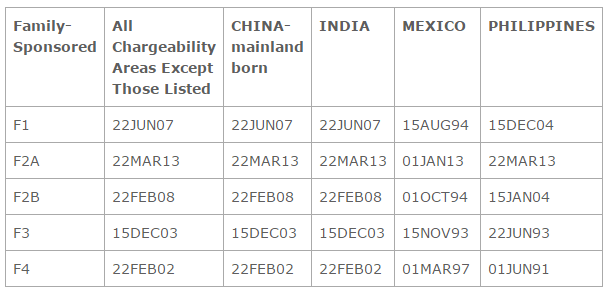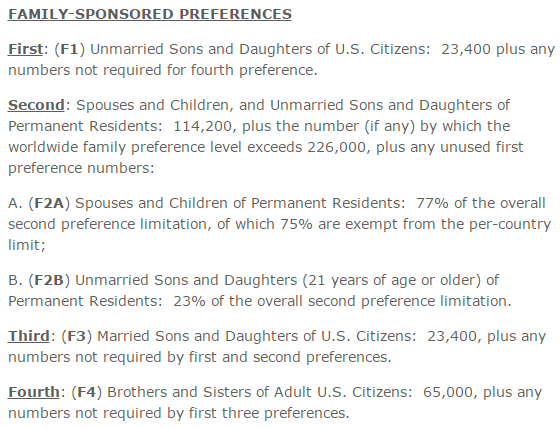 The goal of this post is to provide some basic information to enable you to better understand the U.S. Department of State’s monthly Visa Bulletin with respect a family-sponsored visa petition. It is not a substitute for an attorney. If you need additional information and/or are considering retaining an attorney to help you with your immigration issue, please contact us. Since you are reading this post, you may also be interested in reading a little more in depth on the Visa Bulletin.
The goal of this post is to provide some basic information to enable you to better understand the U.S. Department of State’s monthly Visa Bulletin with respect a family-sponsored visa petition. It is not a substitute for an attorney. If you need additional information and/or are considering retaining an attorney to help you with your immigration issue, please contact us. Since you are reading this post, you may also be interested in reading a little more in depth on the Visa Bulletin.
Many Permanent Resident visas have a waiting period because immigration laws limit the number of visas that can be given out in any one year. Visas for parents, spouses, and children under age 21 of U.S. Citizens are not limited so they are not shown on the Visa Bulletin. The other family-sponsored visas are called preference visas. The table for these visas is the first table shown on the Visa Bulletin. Here is an example, from the December 2014 Visa Bulletin, of what the family-sponsored preferences table looks like:
 To read it, you need to know the following factors: your birth country, your preference category, and your petition date.
To read it, you need to know the following factors: your birth country, your preference category, and your petition date.
You birth country determines which column your visa petition falls in. The second column is the “catch-all” column (i..e., excludes the other listed areas in the table), the third column applies to petitioners born in mainland China, the fourth column applies to petitioners born in India, the fifth column applies to petitioners born in Mexico, and the sixth column applies to petitioners born in the Philippines.
Your preference category determines which row your visa petition falls in. The family-sponsored preference categories are identified in the text immediately preceding the table:
 The first and third preference categories apply to visa petitioners that are U.S. Citizens, while the second and fourth preference categories apply to visa petitioners that are Permanent Residents. Note that the third and fourth preference categories also serve as the “catch-all” preference categories.
The first and third preference categories apply to visa petitioners that are U.S. Citizens, while the second and fourth preference categories apply to visa petitioners that are Permanent Residents. Note that the third and fourth preference categories also serve as the “catch-all” preference categories.
Your priority date is the date the USCIS form I-130, Petition for Alien Relative was filed. You can consider this filing date your place in line. The date shown on the Visa Bulletin is called the “cut-off” date. If an I-130 immigrant visa petition is filed earlier in time (has an earlier priority date) than the cut-off date shown on the Visa Bulletin, then an immigrant visa is available. This means that the case will be sent to the State Department’s National Visa Center (NVC) for processing unless the person is eligible to file to process in the U.S. If the person is eligible to file in the U.S. then they can file for Adjustment of Status beginning the first date of the month of the Visa Bulletin.
Leave a Reply